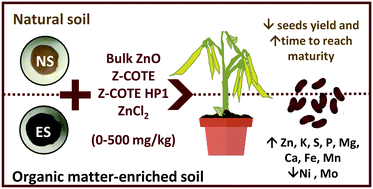当前位置:
X-MOL 学术
›
Environ. Sci.: Nano
›
论文详情
Our official English website, www.x-mol.net, welcomes your feedback! (Note: you will need to create a separate account there.)
Nutritional quality of bean seeds harvested from plants grown in different soils amended with coated and uncoated zinc oxide nanomaterials
Environmental Science: Nano ( IF 7.3 ) Pub Date : 2017-10-12 00:00:00 , DOI: 10.1039/c7en00495h Illya A. Medina-Velo 1, 2, 3, 4, 5 , Osvaldo E. Dominguez 2, 3, 4, 6 , Loren Ochoa 2, 3, 4, 7, 8 , Ana C. Barrios 1, 2, 3, 4 , Jose A. Hernández-Viezcas 1, 2, 3, 4, 5 , Jason C. White 4, 9, 10, 11 , Jose R. Peralta-Videa 1, 2, 3, 4, 12 , Jorge L. Gardea-Torresdey 1, 2, 3, 4, 12
Environmental Science: Nano ( IF 7.3 ) Pub Date : 2017-10-12 00:00:00 , DOI: 10.1039/c7en00495h Illya A. Medina-Velo 1, 2, 3, 4, 5 , Osvaldo E. Dominguez 2, 3, 4, 6 , Loren Ochoa 2, 3, 4, 7, 8 , Ana C. Barrios 1, 2, 3, 4 , Jose A. Hernández-Viezcas 1, 2, 3, 4, 5 , Jason C. White 4, 9, 10, 11 , Jose R. Peralta-Videa 1, 2, 3, 4, 12 , Jorge L. Gardea-Torresdey 1, 2, 3, 4, 12
Affiliation

|
The effects of soil properties on nanomaterial (NM) interactions with plants are not well understood. Bean (Phaseolus vulgaris) plants were grown to maturity in natural soil (NS) or organic matter (OM)-enriched soil (ES) amended with either uncoated (Z-COTE), hydrophobically-coated (Z-COTE HP1) ZnO NMs, bulk ZnO, or ZnCl2 at 0–500 mg kg−1. At harvest, yield and seed nutrient composition were assessed. The soil × compound interaction reduced the maturation time by about 25 days and increased the seed yield (∼155%) in ES, compared to NS. In NS, ZnCl2 at 125 mg kg−1 produced 10% less seed protein than the control, and disregarding the concentration, seeds from ZnCl2 showed the highest relative sugar content (102%, compared with the other compounds), while in NS, seeds from Z-COTE HP1 accumulated the highest relative sugar content (44% more than Z-COTE and ZnCl2). In addition, seeds from ES + Z-COTE HP1 had 19% less Zn than the rest of the compounds. In ES, the OM enrichment and reduction in pH enhanced the accumulation of Zn (38%), K (64%), S (44%), P (83%), Mg (86%), Ca (70%), Fe (89%), and Mn (85%), but reduced Mo under Z-COTE HP1 and ZnCl2, in comparison to NS seeds. Compared to the controls, ZnCl2 at 500 mg kg−1 reduced the K content in NS and ES (25% and 13%) but increased the P content in NS (66%). In general, Z-COTE and Z-COTE HP1 affected seed nutritional elements in a similar manner. However, the results indicate that the effects of ZnO NMs in bean plants vary with soil composition.
中文翻译:

用有涂层和无涂层氧化锌纳米材料改良从不同土壤中生长的植物收获的豆种子的营养品质
土壤特性对纳米材料(NM)与植物相互作用的影响尚不十分清楚。在天然土壤(NS)或富含有机质(OM)的土壤(ES)中,用未涂覆的(Z-COTE),疏水涂覆的(Z-COTE HP1)ZnO NMs将豆类(菜豆)生长至成熟。体积为ZnO或ZnCl 2的浓度为0–500 mg kg -1。在收获时,评估产量和种子营养成分。与NS相比,土壤与化合物的相互作用减少了ES的成熟时间约25天,并增加了ES的种子产量(约155%)。在NS中,以125 mg kg -1的ZnCl 2产生的种子蛋白比对照少10%,并且不考虑浓度,ZnCl 2产生的种子相对糖含量最高(与其他化合物相比,为102%),而在NS中,来自Z-COTE HP1的种子累积的相对糖含量最高(比Z-COTE和ZnCl 2高44%)。此外,来自ES + Z-COTE HP1的种子比其他化合物的Zn少19%。在ES中,OM的富集和pH的降低增强了Zn(38%),K(64%),S(44%),P(83%),Mg(86%),Ca(70%),与NS种子相比,Fe(89%)和Mn(85%)在Z-COTE HP1和ZnCl 2下还原了Mo。与对照组相比,ZnCl 2在500 mg kg -1下降低了NS和ES中的K含量(分别为25%和13%),但增加了NS中的P含量(66%)。通常,Z-COTE和Z-COTE HP1以相似的方式影响种子的营养成分。但是,结果表明,ZnO NMs在豆类植物中的作用随土壤组成而变化。
更新日期:2017-11-01
中文翻译:

用有涂层和无涂层氧化锌纳米材料改良从不同土壤中生长的植物收获的豆种子的营养品质
土壤特性对纳米材料(NM)与植物相互作用的影响尚不十分清楚。在天然土壤(NS)或富含有机质(OM)的土壤(ES)中,用未涂覆的(Z-COTE),疏水涂覆的(Z-COTE HP1)ZnO NMs将豆类(菜豆)生长至成熟。体积为ZnO或ZnCl 2的浓度为0–500 mg kg -1。在收获时,评估产量和种子营养成分。与NS相比,土壤与化合物的相互作用减少了ES的成熟时间约25天,并增加了ES的种子产量(约155%)。在NS中,以125 mg kg -1的ZnCl 2产生的种子蛋白比对照少10%,并且不考虑浓度,ZnCl 2产生的种子相对糖含量最高(与其他化合物相比,为102%),而在NS中,来自Z-COTE HP1的种子累积的相对糖含量最高(比Z-COTE和ZnCl 2高44%)。此外,来自ES + Z-COTE HP1的种子比其他化合物的Zn少19%。在ES中,OM的富集和pH的降低增强了Zn(38%),K(64%),S(44%),P(83%),Mg(86%),Ca(70%),与NS种子相比,Fe(89%)和Mn(85%)在Z-COTE HP1和ZnCl 2下还原了Mo。与对照组相比,ZnCl 2在500 mg kg -1下降低了NS和ES中的K含量(分别为25%和13%),但增加了NS中的P含量(66%)。通常,Z-COTE和Z-COTE HP1以相似的方式影响种子的营养成分。但是,结果表明,ZnO NMs在豆类植物中的作用随土壤组成而变化。



























 京公网安备 11010802027423号
京公网安备 11010802027423号